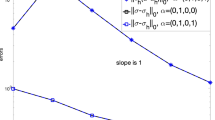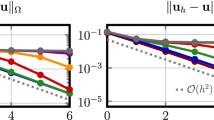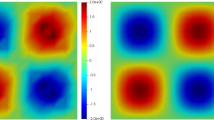Abstract
In this paper, we investigate a low-order robust numerical method for the linear elasticity problem. The method is based on a Bernardi–Raugel-like \(\varvec{H}(\textrm{div})\)-conforming method proposed first for the Stokes flows in [Li and Rui, IMA J. Numer. Anal. 42 (2022) 3711–3734]. Therein, the lowest-order \(\varvec{H}(\textrm{div})\)-conforming Raviart–Thomas space (\(\varvec{RT}_0\)) was added to the classical conforming \(\varvec{P}_1\times P_0\) pair to meet the inf-sup condition, while preserving the divergence constraint and some important features of conforming methods. Due to the inf-sup stability of the \(\varvec{P}_1\oplus \varvec{RT}_0\times P_0\) pair, a locking-free elasticity discretization with respect to the Lamé constant \(\lambda \) can be naturally obtained. Moreover, our scheme is gradient-robust for the pure and homogeneous displacement boundary problem, that is, the discrete \(\varvec{H}^1\)-norm of the displacement is \(\mathcal {O}(\lambda ^{-1})\) when the external body force is a gradient field. We also consider the mixed displacement and stress boundary problem, whose \(\varvec{P}_1\oplus \varvec{RT}_0\) discretization should be carefully designed due to a consistency error arising from the \(\varvec{RT}_0\) part. We propose both symmetric and nonsymmetric schemes to approximate the mixed boundary case. The optimal error estimates are derived for the energy norm and/or \(\varvec{L}^2\)-norm. Numerical experiments demonstrate the accuracy and robustness of our schemes.
Similar content being viewed by others
Data availability
All data generated or analyzed during this study are included in this manuscript.
References
Akbas, M., Gallouët, T., Gaßmann, A., et al.: A gradient-robust well-balanced scheme for the compressible isothermal Stokes problem. Comput. Methods. Appl. Mech. Engrg. 367(113), 069 (2020)
Arnold, D., Falk, R., Winther, R.: Mixed finite element methods for linear elasticity with weakly imposed symmetry. Math. Comp. 76(260), 1699–1723 (2007)
Arnold, D.N., Winther, R.: Mixed finite elements for elasticity. Numer. Math. 92, 401–419 (2002)
Arnold, D.N., Brezzi, F., Cockburn, B., et al.: Unified analysis of discontinuous Galerkin methods for elliptic problems. SIAM J. Numer. Anal. 39(5), 1749–1779 (2002)
Babuška, I., Suri, M.: Locking effects in the finite element approximation of elasticity problems. Numer. Math. 62(1), 439–463 (1992)
Basava, S.R., Wollner, W.: Gradient robust mixed methods for nearly incompressible elasticity. J. Sci. Comput. 95, 93 (2023)
Bernardi, C., Raugel, G.: Analysis of some finite elements for the Stokes problem. Math. Comp. 44(169), 71–79 (1985)
Boffi, D., Brezzi, F., Fortin, M.: Mixed finite element methods and applications, Springer Series in Computational Mathematics, vol. 44. Springer, Heidelberg (2013)
Brenner, S.C., Scott, L.R.: The mathematical theory of finite element methods, Texts in Applied Mathematics, vol. 15, 3rd (edn.) Springer, New York (2008)
Brenner, S.C., Sung, L.Y.: Linear finite element methods for planar linear elasticity. Math. Comp. 59(200), 321–338 (1992)
Chiumenti, M., Valverde, Q., De Saracibar, C.A., et al.: A stabilized formulation for incompressible elasticity using linear displacement and pressure interpolations. Comput. Methods. App. Mech. Engrg. 191(46), 5253–5264 (2002)
Cockburn, B., Shi, K.: Superconvergent HDG methods for linear elasticity with weakly symmetric stresses. IMA J. Numer. Anal. 33(3), 747–770 (2013)
Cockburn, B., Kanschat, G., Schötzau, D.: A note on discontinuous Galerkin divergence-free solutions of the Navier-Stokes equations. J. Sci. Comput. 31(1–2), 61–73 (2007)
Cook, R.D.: Improved two-dimensional finite element. J. Structural. Division 100(9), 1851–1863 (1974)
Crouzeix, M., Raviart, P.A.: Conforming and nonconforming finite element methods for solving the stationary Stokes equations i. Revue française d’automatique informatique recherche opérationnelle Mathématique 7(R3), 33–75 (1973)
Fu, G., Lehrenfeld, C., Linke, A., et al.: Locking-free and gradient-robust H(div)-conforming HDG methods for linear elasticity. J. Sci. Comput. 86(3), 1–30 (2021)
Gatica, G.N.: Analysis of a new augmented mixed finite element method for linear elasticity allowing \({\mathbb{R}\mathbb{T}}_{0}-\mathbb{P}_{1}-\mathbb{P}_{0}\) approximations. ESAIM: Math. Model. Numer. Anal. 40(1), 1–28 (2006)
Gatica, G.N., Gatica, L.F., Stephan, E.P.: A dual-mixed finite element method for nonlinear incompressible elasticity with mixed boundary conditions. Comput. Methods. Appl. Mech. Engrg. 196(35–36), 3348–3369 (2007)
Gatica, G.N., Márquez, A., Meddahi, S.: An augmented mixed finite element method for 3D linear elasticity problems. J. Comput. Appl. Math. 231(2), 526–540 (2009)
Hansbo, P., Larson, M.G.: Discontinuous Galerkin and the Crouzeix–Raviart element: application to elasticity. ESAIM: Math. Model. Numer. Anal. 37(1), 63–72 (2003)
Hu, J.: Finite element approximations of symmetric tensors on simplicial grids in \(\mathbb{R}^{n}\): The higher order case. J. Comput. Math. pp. 283–296 (2015)
Hu, J., Schedensack, M.: Two low-order nonconforming finite element methods for the Stokes flow in three dimensions. IMA J. Numer. Anal. 39(3), 1447–1470 (2018)
Hu, J., Zhang, S.: Finite element approximations of symmetric tensors on simplicial grids in \(\mathbb{R} ^n\): the lower order case. Math. Model. Method Appl. Sci. 26(09), 1649–1669 (2016)
Jin, S.: Efficient asymptotic-preserving (ap) schemes for some multiscale kinetic equations. SIAM J. Sci. Comput. 21(2), 441–454 (1999)
John, V.: Finite element methods for incompressible flow problems, Springer Series in Computational Mathematics, vol. 51. Springer, Cham (2016)
John, V., Linke, A., Merdon, C., et al.: On the divergence constraint in mixed finite element methods for incompressible flows. SIAM Rev. 59(3), 492–544 (2017)
Kouhia, R., Stenberg, R.: A linear nonconforming finite element method for nearly incompressible elasticity and Stokes flow. Comput. Methods Appl. Mech. Engrg. 124(3), 195–212 (1995)
Lamichhane, B.P.: Inf-sup stable finite-element pairs based on dual meshes and bases for nearly incompressible elasticity. IMA J. Numer. Anal. 29(2), 404–420 (2009)
Li, X., Rui, H.: A low-order divergence-free H(div)-conforming finite element method for Stokes flows. IMA J. Numer. Anal. 42(4), 3711–3734 (2022)
Linke, A.: On the role of the Helmholtz decomposition in mixed methods for incompressible flows and a new variational crime. Comput. Methods. Appl. Mech. Engrg. 268, 782–800 (2014)
Linke, A., Merdon, C.: Pressure-robustness and discrete Helmholtz projectors in mixed finite element methods for the incompressible Navier-Stokes equations. Comput. Methods. Appl. Mech. Engrg. 311, 304–326 (2016). https://doi.org/10.1016/j.cma.2016.08.018
Linke, A., Matthies, G., Tobiska, L.: Robust arbitrary order mixed finite element methods for the incompressible Stokes equations with pressure independent velocity errors. ESAIM: Math. Model. Numer. Anal. 50(1), 289–309 (2016)
Malkus, D.S., Hughes, T.J.: Mixed finite element methods-reduced and selective integration techniques: a unification of concepts. Comput. Methods. Appl. Mech. Engrg. 15(1), 63–81 (1978)
Phillips, P.J., Wheeler, M.F.: Overcoming the problem of locking in linear elasticity and poroelasticity: an heuristic approach. Comput. Geosci. 13, 5–12 (2009)
Qiu, W., Shen, J., Shi, K.: An HDG method for linear elasticity with strong symmetric stresses. Math. Comp. 87(309), 69–93 (2018)
Rui, H., Sun, M.: A locking-free finite difference method on staggered grids for linear elasticity problems. Comput. Math. Appl. 76(6), 1301–1320 (2018)
Wang, J., Ye, X.: New finite element methods in computational fluid dynamics by H(div) elements. SIAM J. Numer. Anal. 45(3), 1269–1286 (2007)
Wihler, T.: Locking-free adaptive discontinuous Galerkin FEM for linear elasticity problems. Math. Comp. 75(255), 1087–1102 (2006)
Yi, S.Y.: A study of two modes of locking in poroelasticity. SIAM J. Numer. Anal. 55(4), 1915–1936 (2017)
Yi, S.Y.: A lowest-order weak Galerkin method for linear elasticity. J. Comput. Appl. Math. 350, 286–298 (2019)
Yi, S.Y., Lee, S., Zikatanov, L.: Locking-free enriched Galerkin method for linear elasticity. SIAM J. Numer. Anal. 60(1), 52–75 (2022)
Zdunek, A., Neunteufel, M., Rachowicz, W.: On pressure robustness and independent determination of displacement and pressure in incompressible linear elasticity. Comput. Methods. Appl. Mech. Engrg. 403(115), 714 (2023)
Zhang, M., Zhang, S.: A 3D conforming-nonconforming mixed finite element for solving symmetric stress Stokes equations. Int. J. Numer. Anal. Model. 14(4–5), 730–743 (2017)
Funding
This work was supported by the National Natural Science Foundation of China (Grant 12131014).
Author information
Authors and Affiliations
Corresponding author
Ethics declarations
Conflict of interest
The authors declare no competing interests.
Additional information
Communicated by: Lourenco Beirao da Veiga
Publisher's Note
Springer Nature remains neutral with regard to jurisdictional claims in published maps and institutional affiliations.
Rights and permissions
Springer Nature or its licensor (e.g. a society or other partner) holds exclusive rights to this article under a publishing agreement with the author(s) or other rightsholder(s); author self-archiving of the accepted manuscript version of this article is solely governed by the terms of such publishing agreement and applicable law.
About this article
Cite this article
Li, H., Li, X. & Rui, H. Analysis of a \(\varvec{P}_1\oplus \varvec{RT}_0\) finite element method for linear elasticity with Dirichlet and mixed boundary conditions. Adv Comput Math 50, 13 (2024). https://doi.org/10.1007/s10444-024-10107-w
Received:
Accepted:
Published:
DOI: https://doi.org/10.1007/s10444-024-10107-w




